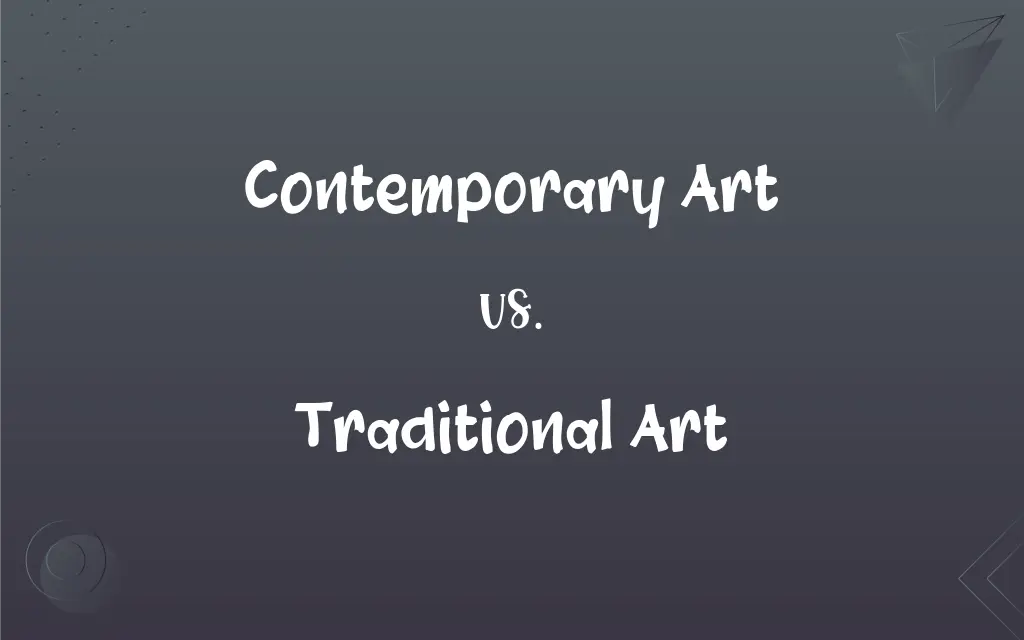Contemporary Art vs. Traditional Art: What's the Difference?
Edited by Janet White || By Harlon Moss || Updated on October 2, 2023
Contemporary art is artwork from the late 20th century onwards, often exploring modern themes, whereas traditional art adheres to established artistic conventions and styles.

Key Differences
Contemporary art confidently steps beyond convention, immersing itself in a dialogue with societal shifts, technological advances, and cultural fluidity, thus framing itself as a mirror reflecting modern existence, ideologies, and questions.
Traditional art roots itself firmly within established norms, techniques, and themes, often maintaining a robust adherence to recognized and historically esteemed artistic methodologies, frequently drawing upon natural, religious, or classical inspirations.
With contemporary art, artists often embrace an experimental attitude, willingly exploring unconventional mediums, provocative themes, and hybrid techniques, enabling a wide spectrum of expressions and discussions pertinent to current global and local contexts.
Conversely, traditional art frequently valorizes aesthetic beauty, technical skill, and a harmonious balance within the composition, with artists often dedicating themselves to mastering established, historically validated forms, such as landscapes, portraits, and still lifes.
While contemporary art navigates the waters of the present, offering a platform to voices from various social, political, and cultural spectra, it opens dialogues and poses questions, often without prescribing specific answers or adhering to aesthetic criteria.
ADVERTISEMENT
In contrast, traditional art, with its often meticulous craftsmanship and recognizable forms, provides a window to bygone eras, illustrating historical aesthetics, ideologies, and societal structures, thereby offering a visual repository of the cultural tapestry of the past.
Comparison Chart
Timeframe
Late 20th century onwards.
Pre-late 20th century.
Themes and Subjects
Modern, relevant, and often provocative.
Classical, natural, and often religious.
Techniques and Medium
Experimental and varied.
Established and historically validated.
Representation
May be abstract, conceptual, or representational.
Primarily representational and aesthetic.
ADVERTISEMENT
Purpose
Often to provoke thought or comment on society/culture.
Display of skill, beauty, and established themes.
Contemporary Art and Traditional Art Definitions
Contemporary Art
Art that reflects and explores modern themes and ideas.
The gallery displayed contemporary art addressing environmental crises.
Traditional Art
Art adhering to historical styles and techniques.
The museum showcased traditional art from the Renaissance period.
Contemporary Art
Artistic works produced during the late 20th century or in the 21st century.
His collection of contemporary art was notable for its vibrancy and variety.
Traditional Art
Art that typically draws upon recognized and respected themes.
The artist dedicated her life to creating traditional art inspired by mythology.
Contemporary Art
Art that often utilizes unconventional mediums and methods.
The contemporary art piece used recycled materials to form a sculpture.
Traditional Art
Artwork primarily focused on beauty, skill, and familiar themes.
Traditional art of the 18th century often revolved around nature and aristocracy.
Contemporary Art
Art that engages with present-day issues and technologies.
Virtual reality has become a fascinating tool in contemporary art experiences.
Traditional Art
Art that emphasizes established methods and aesthetics.
His traditional art creation celebrated detailed and balanced compositions.
Contemporary Art
Art that can be abstract, conceptual, or have socio-political themes.
The contemporary art installation sparked debates on social media platforms.
Traditional Art
Art that values craftsmanship and historical continuity.
The traditional art piece depicted a serene landscape with meticulous detail.
FAQs
Is contemporary art always visual?
No, it can encompass visual, auditory, performance, and interactive installations.
What is contemporary art?
Contemporary art refers to art produced in the late 20th century onwards, reflecting the ideas and concerns of the present.
How does contemporary art differ from modern art?
While both belong to recent periods, modern art generally refers to art from the late 19th century to the mid-20th century, whereas contemporary art starts from the 1960s and continues to the present.
What are common themes in contemporary art?
Contemporary art often tackles political, social, and cultural issues, identity, the body, and the digital age, among others.
Why is some contemporary art difficult to understand?
It often pushes boundaries, challenges conventions, and may prioritize concept over aesthetics.
Do contemporary artists receive formal training?
While many do, others are self-taught or come from non-art backgrounds.
Where can I view contemporary art?
It's often displayed in galleries, museums, art fairs, and public spaces.
How does traditional art differ from contemporary art?
While contemporary art reflects current times and often challenges conventions, traditional art adheres to long-standing techniques and themes.
Is contemporary art valuable?
While its value can be subjective, some contemporary artworks fetch high prices in auctions and galleries.
How has technology impacted contemporary art?
Technology has introduced new mediums like digital art, video installations, and virtual reality in the contemporary art scene.
How has traditional art influenced contemporary art?
Many contemporary artists draw inspiration from traditional motifs, techniques, and themes, blending them with modern sensibilities.
Give examples of traditional art forms.
Examples include calligraphy, pottery, weaving, and folk painting.
Is traditional art always from the distant past?
No, artists still practice and produce traditional art today.
How is traditional art preserved?
Through museums, cultural institutions, and by artisans who continue the practice.
Do traditional artists receive formal training?
Training often happens through apprenticeships and is passed down through generations.
Where can I view traditional art?
In cultural museums, heritage sites, festivals, and many community events.
What is traditional art?
Traditional art refers to art forms that are rooted in a culture's history, practices, and established techniques.
Is traditional art only visual?
No, it encompasses dance, music, and oral storytelling, among others.
Why is traditional art important?
It offers insights into cultural histories, values, and identities.
How is contemporary art critiqued?
Critiques may focus on originality, technique, message, and its reflection on or challenge to society.
About Author
Written by
Harlon MossHarlon is a seasoned quality moderator and accomplished content writer for Difference Wiki. An alumnus of the prestigious University of California, he earned his degree in Computer Science. Leveraging his academic background, Harlon brings a meticulous and informed perspective to his work, ensuring content accuracy and excellence.
Edited by
Janet WhiteJanet White has been an esteemed writer and blogger for Difference Wiki. Holding a Master's degree in Science and Medical Journalism from the prestigious Boston University, she has consistently demonstrated her expertise and passion for her field. When she's not immersed in her work, Janet relishes her time exercising, delving into a good book, and cherishing moments with friends and family.
































































